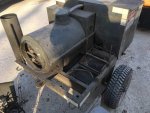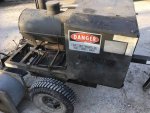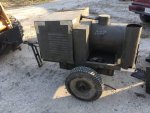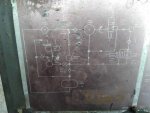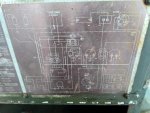Wire Fox
Well-known member
- 1,252
- 161
- 63
- Location
- Indianapolis, Indiana
I just brought home an older ground support heater, NSN 4520-01-056-4269, manufactured by Davey Compressor Company of Cincinnati, Ohio. It's definitely a bit rough around the edges, but it looks like all of the essential equipment is there and in-tact. The hour meter reads out about 1400 hours, so it seems that it was rather well-loved in its day. Also a nice perk is that when the seller got it, there was a twin also being discarded where the other recipient only really wanted the trailer, so he took most of the other equipment off of it-leaving me with a spare control panel (including the regulators mounted to the under side of it), spare diesel engine, and spare blower assembly. Not a bad deal for all of this at less than the price of single small engine!
I can't find the exact manual for this unit, but have found similar ones that will definitely be helpful on their own; however, if anyone has this manual/T.O., I'd really appreciate it. It should be T.O. 35E7-2-11-11.
This unit appears to use a single shaft-driven fuel pump & fuel filter for both the engine and combustion chamber (if I read it correctly, some similar models seem to indicate having a separate v-belt driven pump for the combuster). Another thing that seems to be different is the trailer chassis and speed rating: most look like they have a sort of of U or O-shape chassis, but this is a more traditional ladder frame. As well, the wheels are pretty typical to the average small trailer I've seen, the "tow bar" is a nice, full-length trailer tongue that doesn't fold or slide, and there's marking on the trailer indicating a top speed of 50 MPH-much better than the 20 MPH most trailer-mounted H-1 heaters are rated for! As for obvious defects, I've already encountered several cracked O-rings. Without a manual, I know I'm going to need to learn to measure o-rings correctly and pay a visit to my local supply house to replace these one-by-one. As well, to be expected, the fuel is positively bad that's sitting in the tank. I need to drain it all out, clean the tank, try to purge the lines, and change the fuel filter prior to trying to start this.
Oh, and this heater also already helped educate me on what an "oil bath filter" is. I went to check the air filter, expecting to have a dry element or a lightly-oiled foam filter, but then had the bottom drop out and spill oil all over my leg and the floor...oops. After doing some googling to see an example of that filter and realizing that it was meant to be that way-not some odd backflow of oil into the air filter-I accepted that I was just an idiot and proceeded to throw my pants in the washer.
Here's the data pulled from nsn-now:
Will edit soon to mobile upload some pictures... Including the seller's photos right now. Edit 4: there's my pictures I took this morning!
EDIT: This thread is the same unit as mine. The engine P/N matches up, too: https://www.steelsoldiers.com/showthread.php?28300-Heater-Trailer-Help
Another EDIT: Found a document from Hatz-Diesel that gives specs like oil type, volume, temperature ranges, torque specs, and tolerances for the various engines. Assuming I'm interpreting the P/N correctly, this would be a variant of their E-673 engine, which has a full set of specs in the attached PDF.
Edit 3: Found a parts manual that helps my case on the P/N format (LN is a sub-option), plus I also found a repair manual the covers the E-571, 671, 572, 672, 573, and 673 models. I've got the part manual uploaded, but the repair manual won't go through for some reason. I'd be happy to email this to a MOD if they can add upload it for me...






I can't find the exact manual for this unit, but have found similar ones that will definitely be helpful on their own; however, if anyone has this manual/T.O., I'd really appreciate it. It should be T.O. 35E7-2-11-11.
This unit appears to use a single shaft-driven fuel pump & fuel filter for both the engine and combustion chamber (if I read it correctly, some similar models seem to indicate having a separate v-belt driven pump for the combuster). Another thing that seems to be different is the trailer chassis and speed rating: most look like they have a sort of of U or O-shape chassis, but this is a more traditional ladder frame. As well, the wheels are pretty typical to the average small trailer I've seen, the "tow bar" is a nice, full-length trailer tongue that doesn't fold or slide, and there's marking on the trailer indicating a top speed of 50 MPH-much better than the 20 MPH most trailer-mounted H-1 heaters are rated for! As for obvious defects, I've already encountered several cracked O-rings. Without a manual, I know I'm going to need to learn to measure o-rings correctly and pay a visit to my local supply house to replace these one-by-one. As well, to be expected, the fuel is positively bad that's sitting in the tank. I need to drain it all out, clean the tank, try to purge the lines, and change the fuel filter prior to trying to start this.
Oh, and this heater also already helped educate me on what an "oil bath filter" is. I went to check the air filter, expecting to have a dry element or a lightly-oiled foam filter, but then had the bottom drop out and spill oil all over my leg and the floor...oops. After doing some googling to see an example of that filter and realizing that it was meant to be that way-not some odd backflow of oil into the air filter-I accepted that I was just an idiot and proceeded to throw my pants in the washer.
Here's the data pulled from nsn-now:
| MOUNTING TYPE | TRAILER |
| HEAT MEDIUM TYPE | AIR |
| CIRCULATED AIR TYPE | HEATED |
| WIDTH | 55.000 INCHES NOMINAL |
| CURRENT TYPE | DC |
| DEPTH | 70.000 INCHES NOMINAL |
| PRIME MOVER TYPE | DIESEL ENGINE |
| CURRENT RATING IN AMPS | 35.0 |
| HEATING ELEMENT TYPE | BURNER |
| IGNITION METHOD | ELECTRODE |
| HEAT DELIVERY RATE | 400000.0 BRITISH THERMAL UNIT |
| INTEGRAL FUEL TANK CAPACITY | 24.5 GALLONS |
| VOLTAGE IN VOLTS | 24.0 |
| FUNCTIONAL DESCRIPTION | DESIGNED FOR PREHEATING AIRCRAFT ENGINES,COCKPITS AND CABINS WHERE THE AFCT OPERATE IN ARCTIC REGIONS |
| FUEL TYPE | JP-4 JET FUEL AND JP-5 JET FUEL AND DF-A ARCTIC DIESEL FUEL OIL AND DF-1 WINTER DIESEL FUEL OIL AND DF-2 REGULAR DIESEL FUEL OIL |
| HEIGHT | 42.000 INCHES NOMINAL |
| REFERENCE DATA AND LITERATURE | AF TO. 35E7-2-11-1 |
| SPECIFICATION/STANDARD DATA | 81349-MIL-4607 GOVERNMENT SPECIFICATION |
| NONDEFINITIVE SPEC/STD DATA | 4 CLASS |
| UNPACKAGED UNIT WEIGHT | 734.00 POUNDS |
Will edit soon to mobile upload some pictures... Including the seller's photos right now. Edit 4: there's my pictures I took this morning!
EDIT: This thread is the same unit as mine. The engine P/N matches up, too: https://www.steelsoldiers.com/showthread.php?28300-Heater-Trailer-Help
Another EDIT: Found a document from Hatz-Diesel that gives specs like oil type, volume, temperature ranges, torque specs, and tolerances for the various engines. Assuming I'm interpreting the P/N correctly, this would be a variant of their E-673 engine, which has a full set of specs in the attached PDF.
Edit 3: Found a parts manual that helps my case on the P/N format (LN is a sub-option), plus I also found a repair manual the covers the E-571, 671, 572, 672, 573, and 673 models. I've got the part manual uploaded, but the repair manual won't go through for some reason. I'd be happy to email this to a MOD if they can add upload it for me...






Attachments
-
96.2 KB Views: 9
-
108.5 KB Views: 8
-
109.6 KB Views: 9
-
2.2 MB Views: 7
-
1,013.8 KB Views: 6
Last edited:



